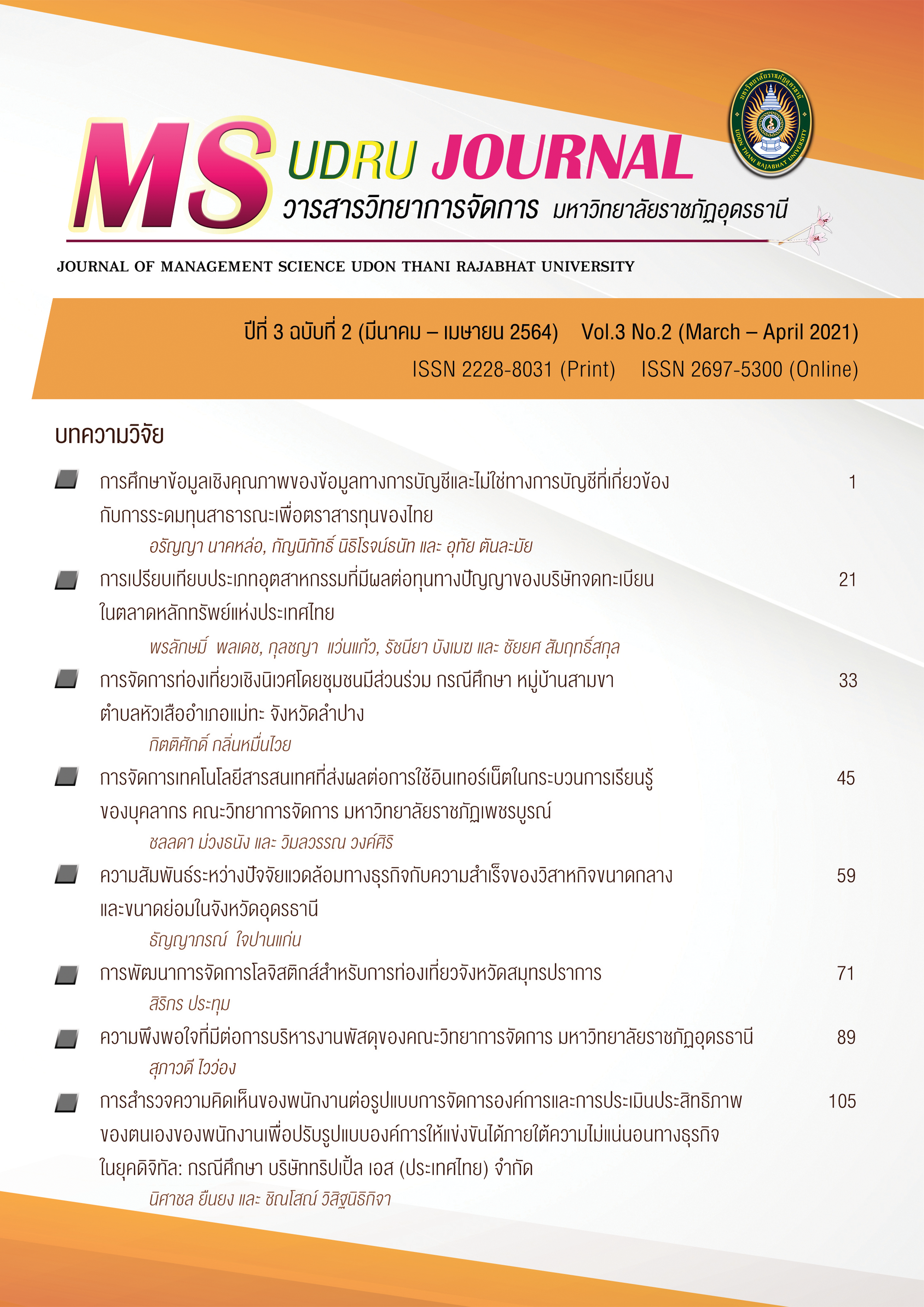COMPARISON OF INDUSTRY TYPES ON INTELLECTUAL CAPITAL OF THAI LISTED COMPANIES
Main Article Content
Abstract
The purpose of this study is to compare types of industries affecting the intellectual capital of listed companies in the Stock Exchange of Thailand, by collecting data throughout year 2015-2017, a total number of 879 samples, by means of descriptive statistics and one-way analysis of variance (ONE-WAY ANOVA) in data analysis. The results of the study found that overall, the listed companies in the Stock Exchange of Thailand had different levels of intellectual capital. The Resource Industry had the highest intellectual capital, followed by the Real Estate and Construction Industry, and the Technology Industry. The paired comparison found that the Technology Industry had the highest physical capital, followed by the Consumer Products Industry. The Resource Industry had the highest human capital, followed by the Human Capital Real Estate Industry and the Consumer Products Industry had the highest structural capital, followed by the Technology Industry.
Article Details

This work is licensed under a Creative Commons Attribution-NonCommercial-NoDerivatives 4.0 International License.
บทความที่ได้รับการตีพิมพ์เป็นลิขสิทธิ์ของคณะวิทยาการจัดการ มหาวิทยาลัยราชภัฏอุดรธานี
ข้อความที่ปรากฏในบทความแต่ละเรื่องในวารสารวิชาการเล่มนี้ ไม่ใช่ความคิดเห็นและความรับผิดชอบของผู้จัดทำ บรรณาธิการ กองบรรณาธิการ และคณะวิทยาการจัดการ มหาวิทยาลัยราชภัฏอุดรธานี ความรับผิดชอบด้านเนื้อหาและการตรวจร่างบทความแต่ละเรื่องเป็นความคิดเห็นของผู้เขียนบทความแต่ละท่าน
References
ตลาดหลักทรัพย์แห่งประเทศไทย. (2558). ตลาดหลักทรัพย์แห่งประเทศไทยมีการจัดโครงสร้างกลุ่มอุตสาหกรรม (Industry Group). สืบค้นเมื่อ 13 พฤษภาคม 2563, จาก www.set.or.th.
อภิชัย พันธเสน และคณะ. (2546). การประยุกต์พระราชดำริเศรษฐกิจพอเพียงกับอุตสาหกรรมขนาดกลางและขนาดย่อม. กรุงเทพฯ: สำนักงานกองทุนสนับสนุนการวิจัย.
อาภรณ์ แกล้วทนงค์. (2561). ความสัมพันธ์ระหว่างการเปิดเผยทุนทางปัญญากับคุณภาพกำไรและมูลค่าราคาตามตลาดของบริษัทจดทะเบียนในตลาดหลักทรัพย์แห่งประเทศไทยกลุ่มอุตสาหกรรมเทคโนโลยี. วารสารสุทธิปริทัศน์, 32(102), 98-115.
Barney, J. B. (2001). Resource-based theories of competitive advantage: A ten-year retrospective on the resource-based view. Journal of management, 27(6), 643-650.
Bontis, N. (2001). Assessing Knowledge Assets: A Review of the Models Used to Measure Intellectual Capital. International Journal of Management Reviews, 3(1), 41-60.
Chen, M.C., S.J. Cheng, Y. Hwang. (2005). An empirical investigation of the relationship between intellectual capital and firms’ market value and financial performance. Journal of Intellectual Capital, 6(2), 159-176.
Clarke, M., Seng, D., & Whiting, R. H. (2011). Intellectual capital and firm performance in Australia. Journal of intellectual capital, 12(4), 505-529.
Edvinsson, L. & Malone, M. S. (1997). Intellectual capital: realizing your company's true value by finding its hidden brainpower.
Herholdt. (2004). South African Journal of Childhood Education 4(1), 42-60.
Jian Xu and Jingsuo Li. (2019). The impact of intellectual capital on SMEs’ performance in China Empirical evidence from non-high-tech vs. high-tech SMEs. Journal of Intellectual Capital, 20(4), 488-509.
Kianto, A.,Hurmelinna-Laukkanen, P.and Ritala, P. (2010). Intellectual capital in service and product oriented companies, Journal of Intellectual Capital, 11(3), 305-325.
Pulic A. (1998). Measuring the Performance of Intellectual Potential in Knowledge Economy. National University.
Theodore W. Schultz. (1971). The Role of Education and of Research. New York: Free Press.


